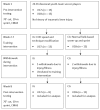The Effects of Six-Weeks Change of Direction Speed and Technique Modification Training on Cutting Performance and Movement Quality in Male Youth Soccer Players
- PMID: 31489929
- PMCID: PMC6783855
- DOI: 10.3390/sports7090205
The Effects of Six-Weeks Change of Direction Speed and Technique Modification Training on Cutting Performance and Movement Quality in Male Youth Soccer Players
Abstract
Cutting manoeuvres are important actions associated with soccer performance and a key action associated with non-contact anterior cruciate ligament injury; thus, training interventions that can improve cutting performance and movement quality are of great interest. The aim of this study, therefore, was to determine the effects of a six-week change of dire[ction (COD) speed and technique modification training intervention on cutting performance and movement quality in male youth soccer players (U17s, n = 8) in comparison to a control group (CG) (U18s, n = 11) who continued 'normal' training. Cutting performance was assessed based on completion time and COD deficit, and the field-based cutting movement assessment score (CMAS) qualitative screening tool was used to assess cutting movement quality. Significant main effects for time (pre-to-post changes) (p ≤ 0.041, η2 = 0.224-0.839) and significant interaction effects of time and group were observed for cutting completion times, COD deficits, and CMASs. Improvements in completion time (p < 0.001, g = 1.63-1.90, -9% to -11% vs. -5% to 6%) and COD deficit (p ≤ 0.012, g = -1.63 to -2.43, -40-52% vs. -22% to -28%) for the COD intervention group (IG) were approximately two-times greater than the CG. Furthermore, lower CMASs (i.e., improved cutting movement quality) were only observed in the IG (p ≤ 0.025, g = -0.85 to -1.46, -23% to -34% vs. 6-19%) compared to the CG. The positive changes in CMASs were attributed to improved cutting technique and reduced incidences of high-risk deficits such as lateral trunk flexion, extended knee postures, knee valgus, hip internal rotation, and improved braking strategies. The results of this study indicate that COD speed and technique modification training, in addition to normal skills and strength training, improves cutting performance and movement quality in male youth soccer players. Practitioners working with male youth soccer players should implement COD speed and technique modification training to improve cutting performance and movement quality, which may decrease potential injury-risk.
Keywords: anterior cruciate ligament; change of direction deficit; cutting movement assessment score; injury risk profiling; movement screening.
Conflict of interest statement
The authors declare no conflict of interest.
Figures








Similar articles
-
Development of a Cutting Technique Modification Training Program and Evaluation of its Effects on Movement Quality and Cutting Performance in Male Adolescent American Football Players.Sports (Basel). 2023 Sep 17;11(9):184. doi: 10.3390/sports11090184. Sports (Basel). 2023. PMID: 37755861 Free PMC article.
-
Biomechanical Effects of a 6-Week Change of Direction Speed and Technique Modification Intervention: Implications for Change of Direction Side step Performance.J Strength Cond Res. 2022 Oct 1;36(10):2780-2791. doi: 10.1519/JSC.0000000000003950. Epub 2021 Mar 2. J Strength Cond Res. 2022. PMID: 33651735 Clinical Trial.
-
Can Unilateral Strength Training Optimize Change of Direction Mechanics and Mitigate Anterior Cruciate Ligament Injury Risk in Female Soccer Players? A Preliminary Pre-Post Intervention Study.Sports (Basel). 2025 Apr 29;13(5):135. doi: 10.3390/sports13050135. Sports (Basel). 2025. PMID: 40423271 Free PMC article.
-
A qualitative screening tool to identify athletes with 'high-risk' movement mechanics during cutting: The cutting movement assessment score (CMAS).Phys Ther Sport. 2019 Jul;38:152-161. doi: 10.1016/j.ptsp.2019.05.004. Epub 2019 May 23. Phys Ther Sport. 2019. PMID: 31153108
-
Altered lower extremity movement variability in female soccer players during side-step cutting after anterior cruciate ligament reconstruction.Am J Sports Med. 2015 Feb;43(2):460-5. doi: 10.1177/0363546514560153. Epub 2014 Dec 15. Am J Sports Med. 2015. PMID: 25512664
Cited by
-
Curve Sprint in Elite Female Soccer Players: Relationship with Linear Sprint and Jump Performance.Int J Environ Res Public Health. 2021 Feb 26;18(5):2306. doi: 10.3390/ijerph18052306. Int J Environ Res Public Health. 2021. PMID: 33652735 Free PMC article.
-
Exercise-Based Training Strategies to Reduce the Incidence or Mitigate the Risk Factors of Anterior Cruciate Ligament Injury in Adult Football (Soccer) Players: A Systematic Review.Int J Environ Res Public Health. 2021 Dec 18;18(24):13351. doi: 10.3390/ijerph182413351. Int J Environ Res Public Health. 2021. PMID: 34948963 Free PMC article.
-
Performance in the Yo-Yo Intermittent Recovery Test May Improve with Repeated Trials: Does Practice Matter?J Funct Morphol Kinesiol. 2023 Jun 6;8(2):75. doi: 10.3390/jfmk8020075. J Funct Morphol Kinesiol. 2023. PMID: 37367239 Free PMC article.
-
Clinical Utility of Qualitative Change of Direction Movement Assessment in ACL Injury Risk Evaluation.Int J Sports Phys Ther. 2024 Oct 1;19(10):1263-1278. doi: 10.26603/001c.123483. eCollection 2024. Int J Sports Phys Ther. 2024. PMID: 39371188 Free PMC article.
-
Predicting Coordination Variability of Selected Lower Extremity Couplings during a Cutting Movement: An Investigation of Deep Neural Networks with the LSTM Structure.Bioengineering (Basel). 2022 Aug 23;9(9):411. doi: 10.3390/bioengineering9090411. Bioengineering (Basel). 2022. PMID: 36134957 Free PMC article.
References
-
- Robinson G., O’Donoghue P., Nielson P. Path changes and injury risk in english fa premier league soccer. Int. J. Perform. Anal. Sport. 2011;11:40–56. doi: 10.1080/24748668.2011.11868528. - DOI
-
- Jones P., Bampouras T.M., Marrin K. An investigation into the physical determinants of change of direction speed. J. Sports Med. Phys. Fit. 2009;49:97–104. - PubMed
-
- Nimphius S. Training change of direction and agility. In: Turner A., Comfort P., editors. Advanced Strength and Conditioning. Routledge; Abdingdon, UK: 2018. pp. 291–308.
LinkOut - more resources
Full Text Sources
Medical

